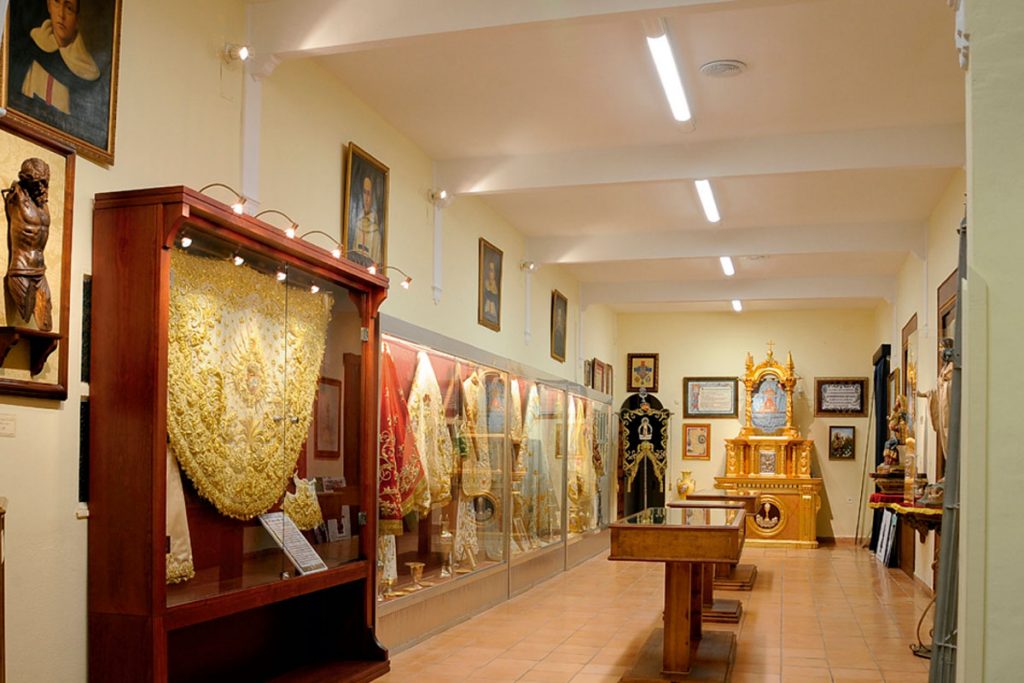In the side wing left looking at the Sanctuary, in the gallery marian by which you access the locker room is the museum of the Sanctuary.
There were many objects of value and works of art that owned the real Shrine and that over the centuries had been enriching its artistic heritage, but the pillage and destruction of the Sanctuary were the cause of the disappearance and destruction of many of them. however, it recovered and preserved parts of a certain value.
The official opening of the “Museum " the Virgin of the Head” took place on the 19th of April, 1998, with the assistance of the civil authorities, religious and the civil guard. It is located in the premise of the Shrine and collect a very important artistic, documentary and anthropological of the historical legacy of devotion to the Virgin of the head has been crossed through the centuries.

The museum is divided into three rooms, emphasizing in the first sheet of greater historical significance, as well as a painting of the Procession of the SEVENTEENTH century and the custody donated by mussolini; in the second, you can see the water given by the kings of Spain and other dignitaries, several reproductions of the image of the Virgin of the head, the cage processional, several display cases with objects of high significance, etc, and in the third room we find a mockup of the Shrine scale of 1/50, the work of D. Manuel Molina, and the gallery of the painter Arsenia Tenerio on the Blessed Elizabeth Canori Mora, among other possessions include:
Cloaks:
The cloak with which the Virgin mary appeared in 1227, and various mantels as the coronation of 1909, embroidered in fine gold on tissue of silver or the mantle of the re-crowning of 1960, donated by the king Alfonso XIII and queen M. ª Eugenia Victoria in 1917, in fulfilment of a promise, the apron of the Virgin on canvas original or the cloak and apron donated by queen Elizabeth II in 1863 on the occasion of a trip he made to the city of Andújar.
Pictures:
Several oil paintings among which are the work of the XVII century, by Bernardo Asturian called “The pilgrimage”. box of great artistic and historical value as it reflects the customs of the Pilgrimage, costumes, and traditions in the century of its composition. the work of Bernardo asturias. (in the literature it is attached to a detailed study of this table with the # 6.- “The procession of the Virgin of the head, in a painting of the XVII century”- Various authors. – edit: Publicaciones obra Social y cultural CajaSur, cordoba, 1997.- 147 pp.) oil on canvas, also of the SEVENTEENTH century, from the private collection of the Gonzalez family Orea.
Documents:
- Statutes of the various confraternities of the blessed Virgin of the head like those of Castro del Río (córdoba), 1646 work carried out on skin of a lamb; of Aguilar de la frontera (córdoba), 1597-frets to two colors.; de Úbeda (Jaén), 1566;
- Statutes of the Confraternity of the Virgin of the head of Úbeda (Jaén). year of 1566, album of the feasts of the seventh centenary of the apparition of our Lady of the head: 1227-1927, gift of shell marble You Of Vallejo (year 1956). And the ordinances of the brotherhood of the Virgin of the head of Baeza (Jaén), 1559, printed in gothic calligraphy on parchment.
- The Enforceable title of royalty in favour of the Shrine of the Sierra morena, granted by the king Alfonso XIII.
- Book of gold the Real Shrine containing the signatures of illustrious pilgrims as the kings of Spain emeritus Juan Carlos and D. ª Sofia.
- Study of philosophical and critical, by the very rev. P. Miguel of San Jose, the minister General of PP. trinitarian. printed in 1759.
- Novena to the Virgin, by Joaquín gravel, superior of the convent trinitarian Andújar, printed in 1862.
Significant Objects:
- Baton donated by Mr. Luis marzal deputy director of the civil guard at the end of his mandate.
- Sash that is placed on the Virgin's head in his appointment as captain general of the Spanish army.
- Cage processional image of the Virgin which dates from the XVI Century, rebuilt in 1960.
- Fossils, minerals and coins from the roman period found in the Sierra morena, as well as remains of the ammunition used in the siege of the Shrine in 1936-1937.
Sacred vessels, and other Objects of Worship:
- Cup, donated by the brotherhood of Madrid.
- Cruets, donated by the devotees as a reminder of the marian pilgrimage to Lourdes in 1960.
- Custody gift of Benito Mussolini, head of the Italian state, this real Shrine on the occasion of the restoration of the same, 1945.
- Chalice of the re-crowning gift of the Excmo. Mr. bishop of Jaén D. Félix Mengibar to the real Sanctuary, on the occasion of the re-crowning of the image of our Lady.1960
- Rosario, in jet and silver filigree.
- Chalice, anonymous donor.
- Custody in golden metal and precious stones, donated by the brotherhood of the Virgin of the head of Palma del río (córdoba), on the occasion of the year
- Marian Jubilee 1959. (he was its founder José Canovaca and older Brother John of God Romero Stripe).
- Mask in ceramic of the current image, made by the Licensed restoration, José Luis Ojeda vessel.
- Carving of the Crucified Christ, Attribution unknown. The middle of the present century. It is made out of carved wood and weathered. Of 1 m. wide x 1’5 m. high. Is wood carving, neo-baroque, with influence of the religious sculpture of the post-war years.

